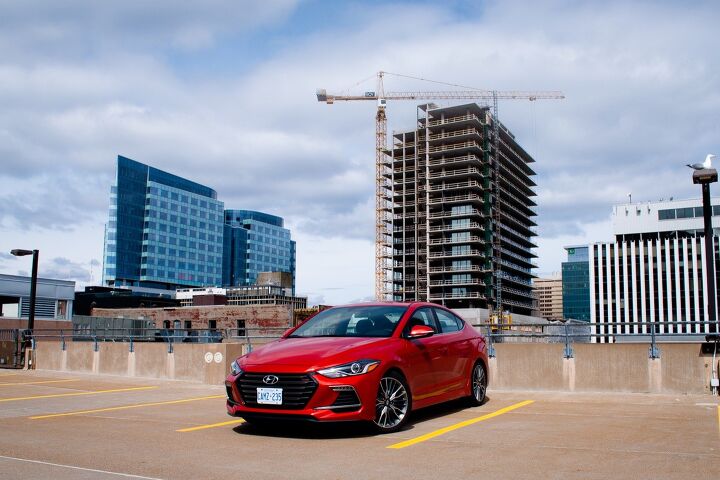2017 Hyundai Elantra Sport Review - Best Version of Hyundai's Best Vehicle
2017 Hyundai Elantra Sport
This is not the 2017 Hyundai Elantra GT3 Superleggera Stradale Competizione with an optional N Performance Package.
The 2017 Hyundai Elantra Sport is not hardcore. It’s not SCCA-certified. It’s not extreme. It’s not uncompromising. And thankfully, it’s not obnoxious, ostentatious, outlandish, or overcooked.
The 2017 Hyundai Elantra Sport is not a Ford Focus RS alternative; it’s not a replacement for your Subaru WRX STI; it won’t satisfy your Renault Sport 230 Renault F1 Team R26.R import cravings.
The $21,650 2017 Hyundai Elantra Sport is, instead, a remarkably balanced junior sports sedan with classy styling and a terrific value quotient, priced $5,100 below the top-spec Elantra Limited.
It’s the best version of Hyundai’s best product.
WHAT DO YOU GET?
It’s enough, particularly with a pleasing six-speed manual shifter and a friendly clutch, to put clear distance between itself and the regular Elantra and its 147-horsepower 2.0-liter.
A seven-speed dual-clutch automatic costs $1,100 extra, and based on our experience with that powertrain combo in the Veloster, we strongly urge you to save $1,100.
Rather than the rear beam axle of other Elantras, the Elantra Sport makes use of multi-link rear suspension, plus a 15mm rear stabilizer bar, rear disc brakes like the Elantra Limited, and bigger wheels than any other Elantras wearing 225/40R18s.
With unique tuning of the suspension and steering plus 54 extra horses, the Elantra Sport is operating in an entirely different sphere from regular Elantras: quicker turn-in, even-keeled cornering, sufficient shove out of corners, and a surprisingly evocative exhaust note that urges you on.
WHAT DON’T YOU GET?
That’s not a chink in the Elantra Sport’s armor. At this low price point — GTI pricing starts $4,800 north of here — the Elantra’s dynamic repertoire is noteworthy.
But livelier steering, which will surely be helped when the Michelin X-Ice tires come off, would dramatically improve the Elantra Sport’s somewhat isolated personality. A modest increase in roll stiffness wouldn’t go amiss. Slightly shorter shifter throws would add to the performance aura. 20 additional lb-ft of torque would allow the Elantra to never feel wanting for extra gumption.
Yet the items from my wishlist missing in the Elantra Sport permit Hyundai to build a balanced car with a low price of entry.
For a car with this much cornering appetite, ride quality is exemplary. Less aggressive steering response enables the Elantra Sport to be a possible alternative for less enthusiastic Elantra consumers who want the extra power without any edginess. Hyundai’s noise/vibration/harshness work resulted in a car that feels far more closely linked to the Sonata than the previous Elantra.
WHAT WOULD YOU RATHER GET?
The comparably priced Ford Fiesta ST is undeniably the better driver’s car, but given the Elantra’s expansive rear seat, the Fiesta ST is a less family friendly vehicle.
Like the Elantra Sport, the 2.5-liter-equipped Mazda 3 is lacking a degree of outright performance. But while the 3 is the more willing partner, the Elantra’s turbocharged powerplant is noticeably more flexible at every point on the rev counter.
WILL ANYBODY KNOW YOU GOT WHAT YOU GOT?
The Sport badge isn’t hiding, but nobody actually thinks “Sport” means anything anymore, do they? The turbo text in the front grille is partially hidden by slats, and again, even turbos don’t automatically suggest performance the way they did in 1987.
Yet the fact that the Elantra Sport provides only faint enhancements to an already attractive car is an intrinsic aspect of its appeal. Far too many pseudo-performance cars shout loudly about levels of sportiness they don’t actually possess.
The 2017 Hyundai Elantra Sport, on the other hand, styles softly and carries a medium-sized stick.
Timothy Cain is the founder of GoodCarBadCar.net, which obsesses over the free and frequent publication of U.S. and Canadian auto sales figures. Follow on Twitter @timcaincars.
More by Timothy Cain
Latest Car Reviews
Read moreLatest Product Reviews
Read moreRecent Comments
- Wjtinfwb My comment about "missing the mark" was directed at, of the mentioned cars, none created huge demand or excitement once they were introduced. All three had some cool aspects; Thunderbird was pretty good exterior, let down by the Lincoln LS dash and the fairly weak 3.9L V8 at launch. The Prowler was super cool and unique, only the little nerf bumpers spoiled the exterior and of course the V6 was a huge letdown. SSR had the beans, but in my opinion was spoiled by the tonneau cover over the bed. Remove the cover, finish the bed with some teak or walnut and I think it could have been more appealing. All three were targeting a very small market (expensive 2-seaters without a prestige badge) which probably contributed. The PT Cruiser succeeded in this space by being both more practical and cheap. Of the three, I'd still like to have a Thunderbird in my garage in a classic color like the silver/green metallic offered in the later years.
- D Screw Tesla. There are millions of affordable EVs already in use and widely available. Commonly seen in Peachtree City, GA, and The Villages, FL, they are cheap, convenient, and fun. We just need more municipalities to accept them. If they'll allow AVs on the road, why not golf cars?
- ChristianWimmer Best-looking current BMW in my opinion.
- Analoggrotto Looks like a cheap Hyundai.
- Honda1 It really does not matter. The way bidenomics is going nobody will be able to afford shyt.







































Comments
Join the conversation
Wouldn't mind seeing this trim level in more of a sports wagon type configuration, something like the size of a 2005-2007 Impreza wagon. Neat car, I didn't know this existed either.
Completely agree. According to https://typeofcars.com/details/hyundai-elantra-2017 , the elantra is best not only in its compact cars class, but also the best Hyundai.